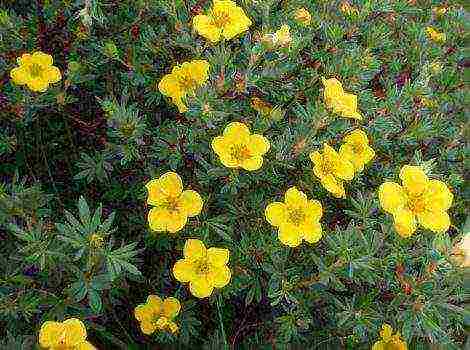Content [show]
As a result of the painstaking work of scientists the classic violet with blue flowers became the progenitor for a large number of new varieties... Violets are distinguished by a variety of shapes and shades. Double or semi-double flowers appeared. The colors have mixed with each other, now on the windowsills of avid collectors you can contemplate violets with patterns, spots, stains, blotches, stripes and contrasting borders. What are violets? Let's take a closer look at the most popular varietal violets described in this article.
Types and varieties of Saintpaulia, a description of a houseplant
All violets were divided into several groups to facilitate orientation among the many species. There are three groups:
- collectible;
- variegated;
- industrial.
Variegated varieties are characterized by the brightest color of the leaves, which can be painted in different colors... They often have a border at the edges. The first variegated varieties bloomed small and uncomplicated sotsveia, but later breeders bred species that were distinguished by large double flowers of different colors.
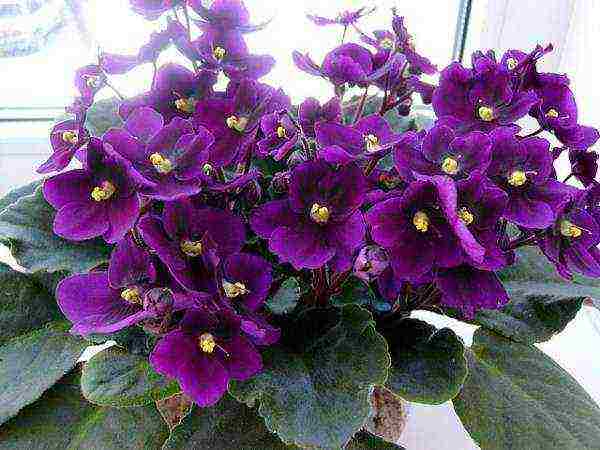 Industrial dutch violet
Industrial dutch violet
Industrial - intended for mass cultivation on special plantations... They are available for purchase in large quantities. Their appearance is the simplest. Basically, these plants are used to decorate banquet halls, they are placed in offices and government agencies. These varieties bloom actively for a long time.
They require minimal maintenance, so they are often grown at home.
Collectible
They are characterized by large inflorescences ranging in size from five to seven centimeters. They differ from others in that they are almostthey have large wavy double petals, painted in the widest range of colors: from pure white to deep blue shades. The leaves are also of different colors and have wavy edges.
Violets of these varieties are collected by collectors and shown at exhibitions.
The most beautiful and unusual varieties are collected at exhibitions. Difficult collectible varieties take more time and effort to grow successfully and care properly. Labor is rewarded with gorgeous flowering. Collectible violets include: Lemon Snow, Willodene, Gift for a loved one and many more.
Name difference
Saintpaulia and Uzambara violet are the names of the same plant that is cultivated at home. Saintpaulia is a Latin scientific name, and the Uzambara violet is a folk... People began to call Saintpaulia the Uzambara violet, because in its natural environment the plant is found in the Uzambar mountains.
Viola - Latin name for violets, which are grown in gardens.
Purple
Currant dessert
Currant dessert
They take the form of stars, they are very fluffy and semi-double. Fringe of an unusual color stretches along the edges of the petals: it resembles the shade of blackcurrant jam. The velvety leaves are colored green. The variety is quite unpretentious, suitable for beginners.
Winter rose
Violet Winter Rose
In shape, the flowers strongly resemble pink inflorescences, which is why the variety bears this name. The petals are dark blue-violet. A thin snow-white edging runs along the edges... Small leaves are colored deep green. Winter rose conveys the quality of the variety well.
Baltika
Violet Baltic
The jagged-topped leaves form a compact rosette in a bright green hue. They are semi-double. They grow to impressive sizes and turn blue-violet. There is a wide, blurry white border around the edges..
White
Alice Blizzard Bani (Aly's Blizzard Bunny)
Violet Alice Blizzard Baths
Snow-white flowers are small in size and shape strongly resemble stars. The variety belongs to semi-double... The leaves, which take the shape of a heart, are painted in a rich green color. This type is very popular among amateur flower growers.
Snow lace
Violet Snow Lace
The variety is characterized by lush terry flowers of a snow-white shade. There is a bluish speck in the center... The edging of the petals shines with a barely noticeable greenish tint. It blooms very actively and luxuriantly. The leaves are light green.
The bride's bouquet
Violet Bridal Bouquet
It was bred by the Russian breeder Konstantin Morev. Large flowers of delicate white color in the shape of a star with wavy edges are very similar to a wedding bouquet... Blooms profusely. The petals are even in color, there are no blotches and patterns.
Pink
Georgia
Violet Georgia
A variety of fabulous beauty. Large double flowers consist of deep pink petals, along the edges of which lilac blotches are scattered... The wavy edges of the petals are decorated with a thin light green border. Flowers bloom on powerful peduncles. It blooms profusely, subject to the necessary conditions.
Marquise
Violet Marquis
The variety was bred in 2011. Dissolves large double flowers in a rich pink shade... A lilac border with the thinnest snow-white line runs along the edge of the petals. The leaves are dark green. Looks great on the windowsill.
Magdalene
Violet Magdalene
The foliage is colored green. In the middle of the rosette there are large double flowers that resemble a ball. The petals have a wavy edging. Flowers are located very close to each other, which gives the impression of a huge bouquet... Very popular at exhibitions. Many people acquire a leaf of this variety.
Lilac
Lilac beauty
Violet Lilac charm
The variety is distinguished by large purple flowers with specks of rich lilac in the center. There is a dark border on the edge of the petals. The flower stalks are powerful, the rosette of the correct shape consists of round leaves... This variety is easy to care for and is suitable for beginners and even children.
Favorite daughter
Violet Favorite daughter
Flowers are rich lilac color with a border, painted in dark purple. Leaves with teeth are rounded and colored in emerald color... The reverse side has a distinct crimson tint. Flowers are born small and dark. As they develop, they brighten.It can lift up the leaves, so it needs a lot of space on the windowsill. Beautiful and lush flowering almost constantly pleases the grower. They bloom for two to three weeks.
Blue
Blue dragon (Blue Dragon)
Violet Blue Dragon
A well-known variety of the Sorano selection. Almost all collectors have this variety. Popular for its large flowers in a delicate blue color... A greenish-white border stretches along the edges of the petals. The variety is quite moody. It needs a natural light source and cannot tolerate farming mistakes.
Blue Danube
Violet Blue Danube
Bred by Russian breeders. It is characterized by large flowers that are up to five centimeters in size. The petals are pale blue. Matte leaves with wavy edges at the end have small teeth... This variety needs good lighting and proper watering. The abundance and duration of flowering depends on the temperature.
Blue Lagoon
Violet Blue Lagoon
The variety is characterized by large, semi-double, deep blue, star-shaped flowers. It has a blue spot in the center and a purple border around the edges. When there is not enough light, it lifts the leaves up... The flowering period is two months. Unpretentious in care, even a beginner can grow.
Variegated
Lemon Snow
Violet Lemon Snow
The flowers are painted in snow-white color with lemon-colored rays. The middle and edges have a bluish tint. Leaves are variegated, painted in a rich green color... A white border runs along the edge of the leaf.
Willodene
Violet Willodene
A variety with unusually beautiful variegated leaves. Peach flowers with a greenish edging are not the main charm. At exhibitions, attention is paid to wavy leaves, painted in emerald colordiluted with pink and white spots.
Gift for a loved one
Violet Gift for a loved one
Leaves of deep green color with sharp tips and edging in a pink-white hue are of particular value.... The flowers are blue. A purple border runs along the edge. It enjoys great success at exhibitions. Quite an unpretentious variety.
Ampelny
Ampel violets are used for growing in hanging pots. They decorate hanging flower beds and gardens. They have several points of growth, long stems hanging down, and a large number of lateral shoots. The most popular varieties of ampel violets - Trinket Summer Skyes with rounded green leaves and blue flowers and Robs Humpty Doo with light leaves and snow-white flowers.
They need a lot of light. They are able to bloom for a whole year.... In winter, the plant is provided with additional lighting.
Mini varieties
The rosette of miniature violets does not exceed fifteen centimeters in size... At the moment, about two thousand varieties of mini-violets are known.
Mini violets are very popular among flower growers.
Many collectors only collect miniature violets. Caring for miniature violets has some features: they are less whimsical than big brothers.
Among mini-varieties can be distinguished Avatar with simple semi-double flowers of a pale blue hue and variegated leaves. Attracts florists and is gentle a variety called my angel... Simple flowers on powerful peduncles are tinted pink. Leaves of pale green color are distinguished by a wide edging of snow-white color.
What varieties are cultivated at home?
At home, they grow simple violets of the industrial group, variegated and collectible. Beginners are advised to start simple violets to gain experience in grooming. An experienced florist can already grow complex breeding varieties. A huge number of species are grown at home. Experts have bred about thirty-two thousand varieties of indoor Saintpaulias, differing in many ways.: color, shape, structure of leaves and rosettes.
In the wild, there are about twenty species of Saintpaulia. In natural conditions, there are:
Velvet Saintpaulia
Velvet Saintpaulia
On the front side, the leaves are colored green, and the reverse side has a reddish tint... The inflorescence is collected from purple flowers with a dark central part.
Violet Saintpaulia
Violet Saintpaulia
Blue-violet flowers bloom on short stems and rich green, heart-shaped leaves grow. The rosette diameter can be up to sixty centimeters.
Saintpaulia Grotte
Saintpaulia Grotte
Refers to ampel varieties. The pubescent leaves take on a rounded shape... Lilac-blue flowers do not grow more than two and a half centimeters.
Useful properties of violets
Indoor violet can not only please the eyes of the grower, but also help with various diseases. It has a beneficial effect on the body in case of renal inflammation, bronchitis, joint pain and atherosclerosis.... A decoction is prepared from a Saintpaulia leaf filled with boiling water, which is added to tea. Take it during the day. You can bathe children in violet broth. This method will help heal scrofula, rickets, eczema, and skin rashes. Violet tinctures help with tinnitus after childbirth. With the help of a violet leaf, you can get rid of insomnia and neuroses.
Before taking a medicinal broth, you should definitely consult your doctor.
The plant contains poisonous substances that, if used incorrectly, poison the body... There is a month break between courses.
It is difficult to single out the very best varieties of Saintpaulia, given the huge variety. The most beautiful are certainly the collectible varieties.... The most popular among florists are - Winter parasol, Adonis, Rococo Pink and many others.
Indoor violets are one of the most popular types of indoor plants. They are easy to care for and cultivate, and their flowering is long and varied. Every year there are more and more unusual varieties and varieties of indoor Saintpaulias, photos, names and descriptions of which are worthy of attention of both professionals and amateurs of floriculture. The wide range of varieties of this plant also attracts, the ability to plant them in a flower bed or take them out in the summer, as well as incredible palettes of shades. The best ones are presented below.

Types and varieties of Saintpaulia
All violets were divided into several groups to facilitate orientation among the many species. There are three groups:
- collectible;
- variegated;
- industrial.
Variegated varieties are characterized by the brightest color of the leaves, which can be painted in different colors. They often have a border at the edges. The first variegated varieties bloomed small and uncomplicated inflorescences, but later breeders bred species that were distinguished by large double flowers of different colors.
Industrial - designed for mass cultivation on special plantations. They are available for purchase in large quantities. Their appearance is the simplest. Basically, these plants are used to decorate banquet halls, they are placed in offices and government agencies. These varieties bloom actively for a long time.
Collectible - characterized by large inflorescences ranging in size from five to seven centimeters. They differ from others in that almost all have large wavy double petals, painted in the widest range of colors: from snow-white to deep blue shades. The leaves are also of different colors and have wavy edges.
Fresh articles about garden and vegetable garden
Saintpaulia Rosemary
The star-shaped, terry flowers of LE Rosemary violets, the photo of which is presented here, will become a luxurious decoration of any collection. The variety bred by E.Lebetskaya, combines several bright memorable features at once. Not only are the champlevé petals gracefully corrugated, pink strokes and abundant blue splashes look amazing on a white background. The Violet Rosemary is a standard sized plant with a rosette of dark green toothed leaves.

Saintpaulia Caprice
It is difficult to forget and confuse the white foam of violet flowers YAN Caprice of N. Puminova's selection with the flowering of another plant. A flower cap of terry corollas decorated with green fringes is positioned over the variegated wavy foliage.

Saintpaulia Adonis
This variety was developed in France at the end of the 19th century. The main feature of Adonis is the yellow peephole in the center of the flower. The plant is unpretentious, can be grown both on the window and in the garden. Sprawling bush 25 centimeters tall, the leaves are light green in color. Brown streaks are observed at the base of the lower three petals. It blooms in April-August and September-October. She tolerates winter satisfactorily.

Saintpaulia Aphrodite
The variety is named after the ancient Greek goddess of love. The variety has white double flowers with pink-lilac spots and the same border. When the temperature rises, the color becomes bright lilac. Blooms profusely, usually up to 7 flowers in a peduncle. Does not require complex care; for flowering, a lighting rate of 12-13 hours is required.
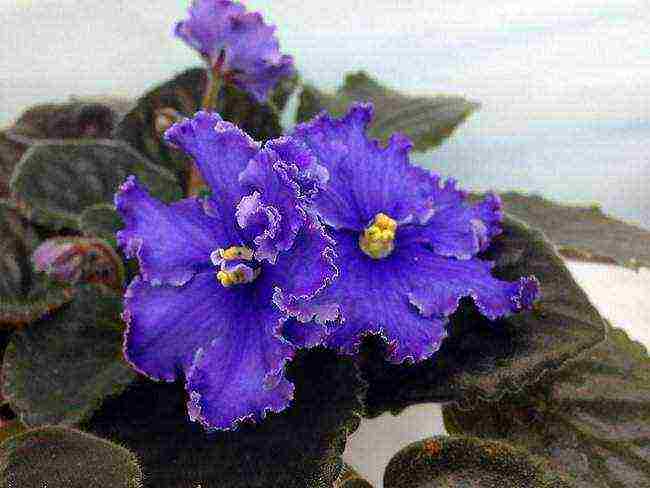
Saintpaulia the Water
Large blue flowers with lightened fragments along the edges of the petals, which have abundant green ruffle. Quilted green leaf with a wavy edge. The buds open gradually and stay in cool weather for more than a month. Peduncles are strong, low, hold from 4 to 6 flowers-balls. Medium socket. All the beauty of the variety is shown in the second bloom.

Saintpaulia Baltic
The jagged-topped leaves form a compact rosette in a bright green hue. They are semi-double. They grow to impressive sizes and turn blue-violet. There is a wide, washed-out white border around the edges.
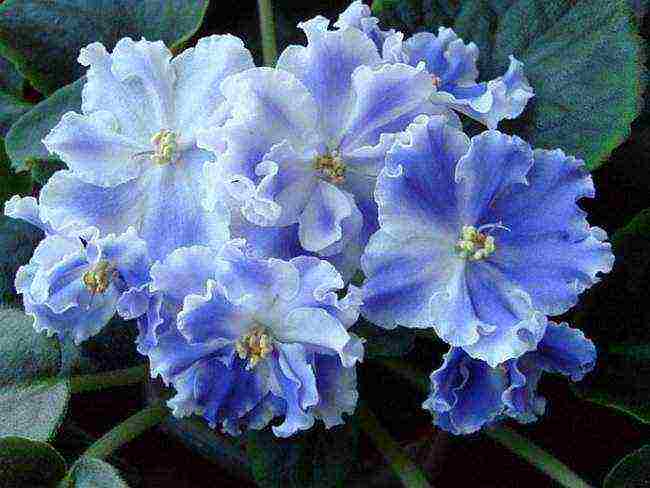
Saintpaulia Alice Blizzard Baths
Home violets Alice Blizzard Baths are small in size and shaped like an asterisk. It is a semi-double variety with white flowers that appear like small stars from the dense dark foliage. Among other representatives who get divorced at home, Alice Blizzard Bani can be called a real leader.
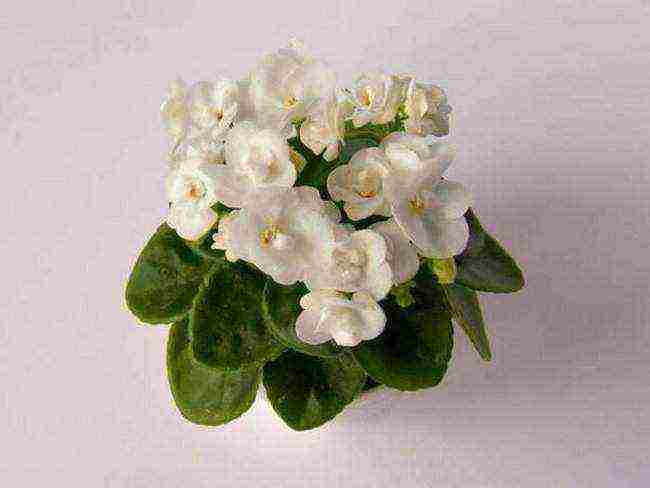
Saintpaulia Snow Lace
Huge terry fringed-wavy snow-white stars with bluish illumination in the center and green along the edges of the petals. Medium green show foliage. Abundant bouquet on strong peduncles.
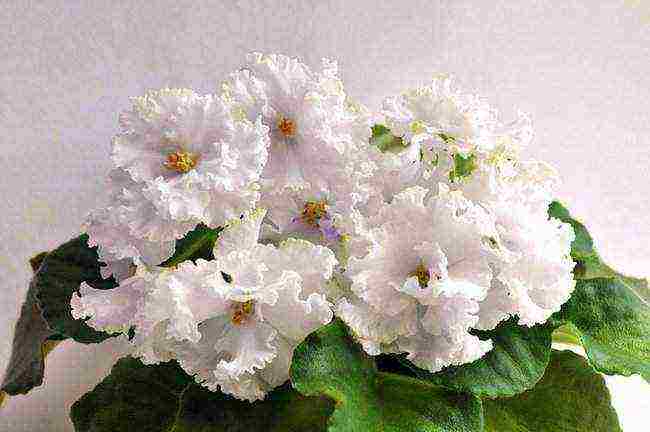
Saintpaulia Marquis
The variety was bred in 2011. Dissolves large double flowers of a rich pink hue. A lilac border with the thinnest snow-white line runs along the edge of the petals. The leaves are dark green. Looks great on the windowsill.

Saintpaulia Alamo Marvel
It looks very much like another variety, Alamo Joy. The flowers are similar in shape and color, but still different. Marvel has a more juicy and rich coral hue. The leaves are large, without pubescence, have a light green color. The flowers are velvety, wavy at the edges.
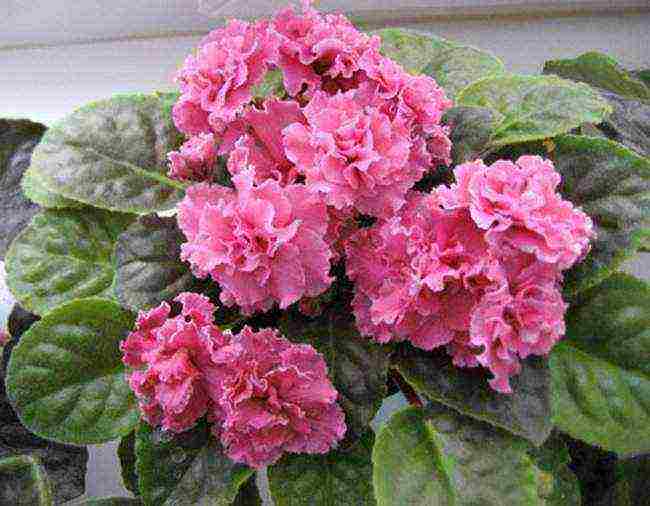
Fresh articles about garden and vegetable garden
Saintpaulia Magungenskaya
The stems are branched, the leaves reach a height of 15 cm, the leaves are quite large 6 cm, have wavy edges. The flowers are purple in color, collected in inflorescences of 2-4 flowers.
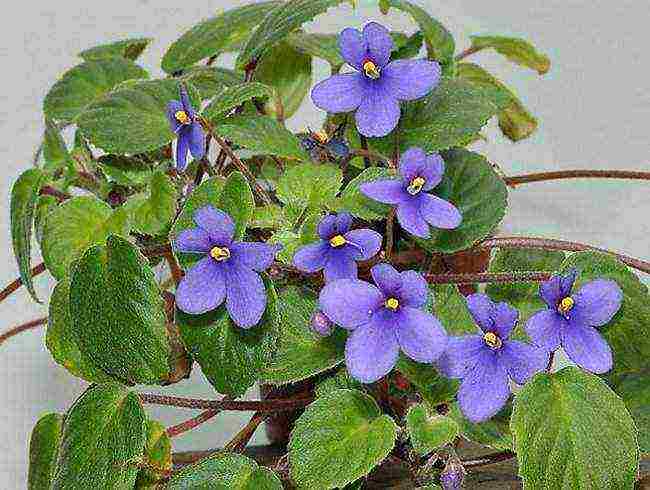
Saintpaulia Frosty Cherry
Semi-double, unusual cherry-red flowers with a white center and border. Over time, the flower darkens, becomes more saturated. The saturation of flowers increases over time and depends on the intensity of the light. If a blooming violet is rearranged to a zone with a lower light intensity, then it will begin to brighten over time. The variety loves warmer conditions, but reacts poorly to a combination of heat and high humidity (double flowers become simple). It is necessary to ventilate the room.At low temperatures, the overall dark area decreases.
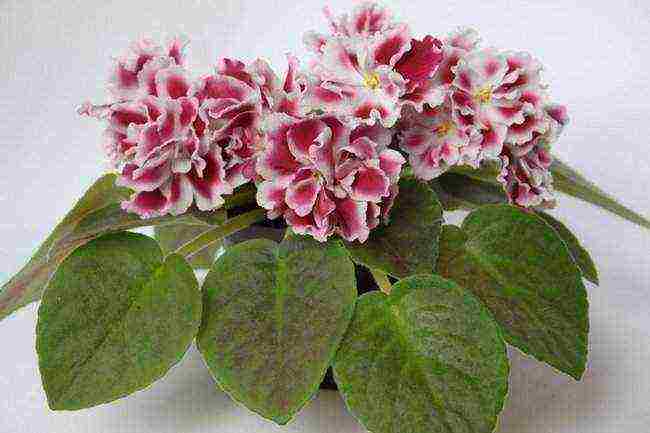
Saintpaulia Paul Bunyan
The Saintpaulia variety is the most suitable for indoor cultivation. The leaves of this variety are rounded, with small teeth, growing on long twigs. There are many flowers, crimson-lilac in color, the size of the flowers is medium. The plant requires constant transplantation, as it grows very intensively.
This kind of indoor violet looks great on wide windowsills. It will complement almost any interior. The flowering period is very long and can be up to eight months with proper care.
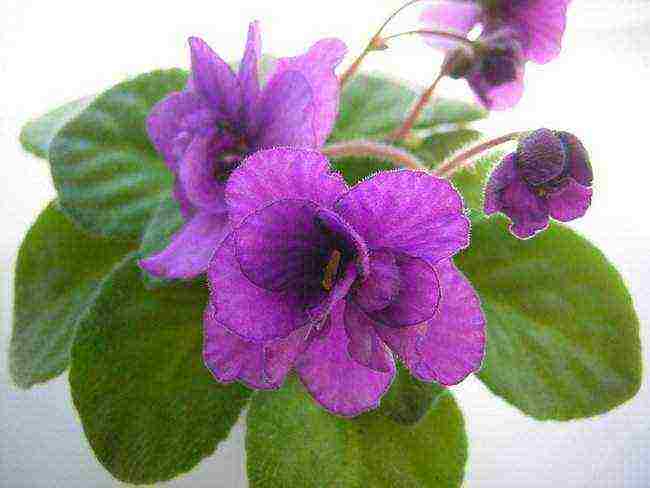
Saintpaulia Duchess
So what about this variety? First of all, the fact that she is really very beautiful, a real duchess! This beauty can please its owner with flowers of unusual texture and color. This variety has very beautiful flowers, corrugated, and also very large in size. To the touch, like most violets, they are terry. The petals of this violet are white in color, but they also show "overprints" of a plum shade. The brightness of the shade can also vary slightly - when the flower is fully bloomed, you will get a rich plum color. The leaves of the RS-Duchess violet are not too large, medium-sized, and against their background the flowers themselves look quite impressive. The foliage is painted in a pleasant dark green color, due to which the flowers of this plant look much more expressive.
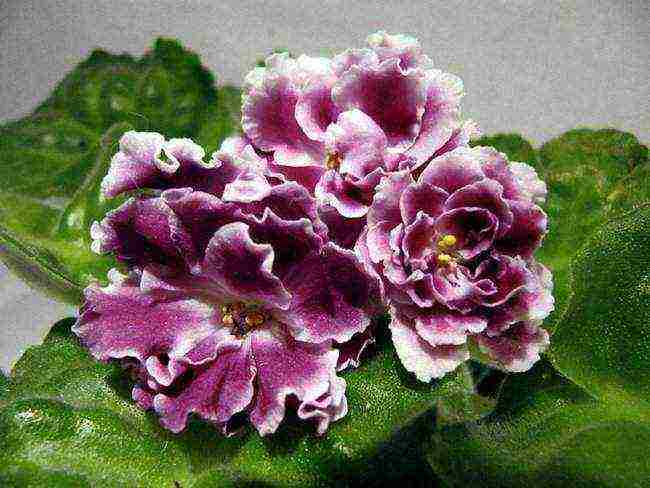
In addition, it should be borne in mind that violets of this variety do not tolerate heat very well. They are focused on a more or less cool climate, therefore, the content of such flowers in sufficiently warm conditions can negatively affect their development. Therefore, if you purchase this variety, the most successful option would be to place this beauty on the north window.
Saintpaulia Blue Mist
The young Russian breeder Konstantin Morev, thanks to regular experiments with Saintpaulias, has created several new attractive varieties. Among them is the violet "Blue Mist", which appeared in 2001. Its distinctive feature is light blue or light blue double flowers with a white border. The rosette is dark green, spreading. Terry flowers differ from ordinary flowers in a multi-row structure of buds and wavy (corrugated) edges of the petals. The variety has a standard size. The rosette is flat, symmetrical; in abundant soil it grows up to 40 cm and more. The foliage is wavy, rounded. Jagged edges, green coloration. The blossoming flowers resemble a ball in shape, their diameter is 7-8 cm. Flowering takes place in waves, between them there is an interval of 1-3 months.
Florists note several advantages of this variety:
- a beautiful hat on persistent peduncles;
- abundant and long flowering;
- easy care;
- rapid growth, flowering up to a year;
- breeds easily.
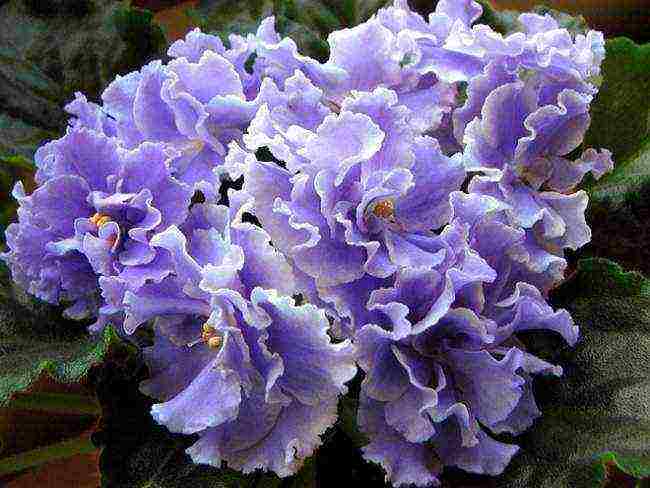
From all this beauty, we tried to choose the most unusual and beautiful varieties.
Almost every grower has a violet. And how can you refuse such beauty. In nature, there are about 500 species of this plant. The territory of their distribution is almost the entire globe. Violet varieties differ in size, color and many other features that only specialists know about. Admiring their beauty and amazing tenderness of flowers, I want to preserve it for a long time and increase it. Each variety of violets is good in its own way, but they require the same care. We will talk about how to grow these amazing plants in this article.
The origin of violets
This beautiful flower is native to East Africa. Until now, many rare varieties of violets are found only there and are even protected. The second name of this plant is saintpaulia. In their natural environment, they grow near waterfalls, in the coastal zone of rivers, where there is a lot of fog and mist.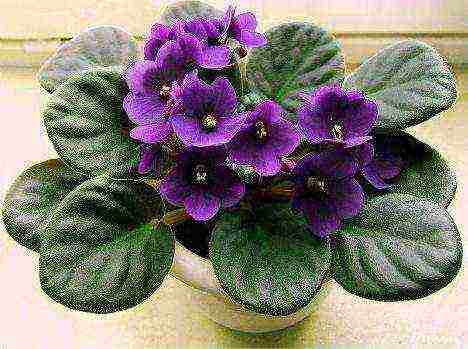 This flower was discovered by Baron Walter Saint-Paul near the Usambar Mountains. He amazed him with his beauty and tenderness.There are many violet-like plants in nature, but only one species, Saintpaulia, was able to take root under conditions of home breeding.
This flower was discovered by Baron Walter Saint-Paul near the Usambar Mountains. He amazed him with his beauty and tenderness.There are many violet-like plants in nature, but only one species, Saintpaulia, was able to take root under conditions of home breeding.
Violet description
Varieties of indoor violets are similar in structure. All of them belong to the Gesneriaceae family and have a second name - the Usambar violet. Plants that are small in size are distinguished by abundant flowering throughout the year, taking only short breaks for rest. This is a perennial flower with juicy, short stems that are collected in a rosette. The violet has wide, oval or slightly round leaves on long petioles. Their apex is slightly pointed, and the edges are wavy. The fleshy leaves are dark or light green in color. They are reddish, green or purple underneath. The plant has a lot of inflorescences, reaching 3-4 centimeters in diameter. Violet flowers are double, semi-double or simple. Their color is the most varied - from white to dark blue. There are varieties that have a two-tone color.
Their apex is slightly pointed, and the edges are wavy. The fleshy leaves are dark or light green in color. They are reddish, green or purple underneath. The plant has a lot of inflorescences, reaching 3-4 centimeters in diameter. Violet flowers are double, semi-double or simple. Their color is the most varied - from white to dark blue. There are varieties that have a two-tone color.
Hybrid varieties
The number of hybrids is many times greater than the main species. Thanks to selection, there are now about 2000 varieties and hybrid forms. Violets are classified according to the color and shape of the flowers and their type. Here you can distinguish star-shaped, classic, edged, fantasy and violets "chimeras". By the type of leaves, Saintpaulias are divided into boys and girls. At the base of the leaf of the "girls" there is a noticeable light spot, the "boys" have a completely green leaf.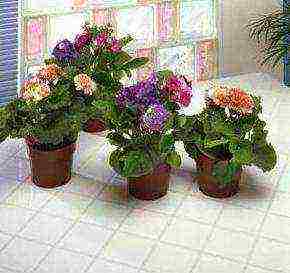 The size of the rosettes of these plants can be up to 60 centimeters. These are violets - giants. More often you see Saintpaulia with an average outlet (up to 40 centimeters). There are also miniature plants with rosettes up to 15 centimeters in diameter, and microminiatures up to 6 centimeters. Violets "chimeras" have a contrasting stripe on the petals. These are the most exotic varieties. They can only be propagated by stepchildren and peduncles. Each variety of violets is good in its own way.
The size of the rosettes of these plants can be up to 60 centimeters. These are violets - giants. More often you see Saintpaulia with an average outlet (up to 40 centimeters). There are also miniature plants with rosettes up to 15 centimeters in diameter, and microminiatures up to 6 centimeters. Violets "chimeras" have a contrasting stripe on the petals. These are the most exotic varieties. They can only be propagated by stepchildren and peduncles. Each variety of violets is good in its own way.
The most famous varieties
There are varieties of Saintpaulias that are in great demand among flower growers. They are common and are quite well adapted to domestic breeding conditions. Many hybrids were bred on their basis. We will consider the varieties of violets and a description of their features in more detail.
Dark Saintpaulia (Saintpaulia confusa) has a straight stem that reaches 10 centimeters in height. Its flowers are bluish-purple in color with yellow anthers and are collected in clusters of 4 pieces. Violet-flowered Saintpaulia (Saintpaulia ionantha) has a different color of inflorescences of bred hybrids: white, pink, blue, red and purple. Her leaves are green above and greenish-red below.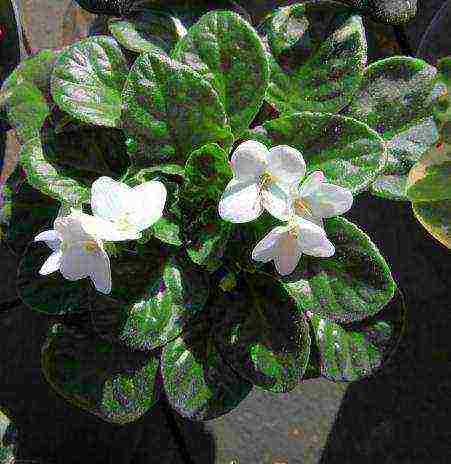 In its natural environment, this plant has only purple-blue flowers. Saintpaulia ionantha or Magungen Saintpaulia has branched stems that reach 15 centimeters in height. The leaves of this plant are about 6 centimeters in diameter and have wavy edges. Violet flowers are purple in color, collected in two or four in inflorescences. Saintpaulia teitensis is a rare protected violet species found only in Kenya. The best varieties of Uzambar violets are headed by Saintpaulia Chimera Monique, which has lilac flowers with a white border. Saintpaulia Chimera Myrthe is distinguished by pink-red petals, which are bordered by a white stripe. The violet Saintpaulia Ramona is a cultivar with dark red flowers with yellow anthers. And finally, the white violet Saintpaulia Nada, which is found in every lover of this plant. The varieties and names of store-bought violets may not be known. Real Saintpaulias with names are found only in specialized nurseries and are very expensive. Home-bred violets may have some mutations.
In its natural environment, this plant has only purple-blue flowers. Saintpaulia ionantha or Magungen Saintpaulia has branched stems that reach 15 centimeters in height. The leaves of this plant are about 6 centimeters in diameter and have wavy edges. Violet flowers are purple in color, collected in two or four in inflorescences. Saintpaulia teitensis is a rare protected violet species found only in Kenya. The best varieties of Uzambar violets are headed by Saintpaulia Chimera Monique, which has lilac flowers with a white border. Saintpaulia Chimera Myrthe is distinguished by pink-red petals, which are bordered by a white stripe. The violet Saintpaulia Ramona is a cultivar with dark red flowers with yellow anthers. And finally, the white violet Saintpaulia Nada, which is found in every lover of this plant. The varieties and names of store-bought violets may not be known. Real Saintpaulias with names are found only in specialized nurseries and are very expensive. Home-bred violets may have some mutations.
We buy violets
What should you look for when buying this plant? First of all, on the leaves. There should be no foreign stains on them. They may indicate that the plant is infected.Such a violet will be difficult to grow. For breeding from a leaf stalk, specimens from the second bottom row should be selected. The lower leaves can be severely depleted and produce fewer babies. Be sure to ask the seller about the variety name. The leaves of the plant should not be strongly extended upward. This indicates a lack of light. The socket must be healthy and free from decay. Violet cuttings and rosettes are very fragile. This must be taken into account when transporting them. The varieties and names of violets should be written and glued to the pot.
What violets love
Each flower requires its own breeding conditions. Regardless of which variety of violets you purchased, find a well-lit place for the plant. But remember that Saintpaulias do not like direct sunlight. From their contact, burns appear on the leaves, and with prolonged exposure to the sun, the flower may die. Violets, the photo and name of the variety of which can be found in this article, love windows on the west and east sides of the building. On the south side, they need to be protected from the sun by shading. The best temperature for comfortable breeding of violets ranges from 20 to 24 degrees. For a large number of violets, you can equip a special rack. The lighting in this case can be artificial. Saintpaulias do not like drafts, especially in winter. Therefore, this must be taken into account during long-term airing.
Watering violets
Any type of violet, white varieties or others, needs moderate watering. For this, it is better to use water at room temperature or slightly warmer. Standing or filtered tap water will do. It is better to water the saintpaulia in a tray. When irrigating from above, you need to try not to get on the leaves, flowers, and especially in the center of the outlet.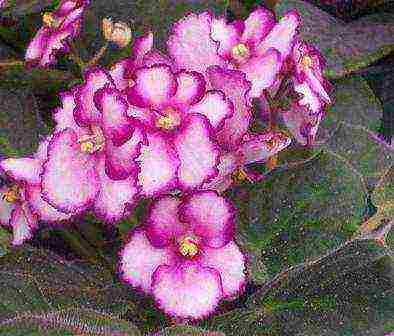 From this, spots appear on the flower, and it may die. After 10-15 minutes, pour out the water from the pan. The plant will absorb the required amount of moisture by this time. The soil of the flower should be moist and not very wet. If the environment is more moist, the rosette and root system will rot. Watering is carried out on average 1-2 times a week, but it depends on the season, soil quality and room temperature. Sometimes the violets are sprayed. This procedure will be useful in the summer. But it must be carried out with caution, do not allow the sun to hit the wet plant.
From this, spots appear on the flower, and it may die. After 10-15 minutes, pour out the water from the pan. The plant will absorb the required amount of moisture by this time. The soil of the flower should be moist and not very wet. If the environment is more moist, the rosette and root system will rot. Watering is carried out on average 1-2 times a week, but it depends on the season, soil quality and room temperature. Sometimes the violets are sprayed. This procedure will be useful in the summer. But it must be carried out with caution, do not allow the sun to hit the wet plant.
Plant feeding
Violets do not require frequent feeding. The finished substrate has all the necessary nutrients that are needed for the fruitful development of the plant. Therefore, it is enough to replant each variety of violets once a year or a little more often. To feed Saintpaulia, if it is depleted, use special fertilizers. They are both liquid and granular. Fertilizers should not be highly concentrated. The label must have the designation (NPK). Top dressing can be carried out no more than once a month. Remember that the earthen lump of the plant should not be overdried.
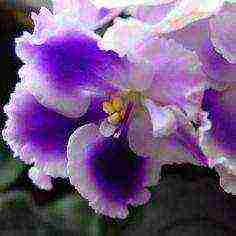 Be sure to read the instructions to properly feed the violet. For young rosettes, the nitrogen content in the soil should exceed the amount of potassium and phosphorus. In order for the plant to form buds and bloom profusely, it must be fed with phosphorus preparations. Then the flowers will be large and bright. Also during this period, Saintpaulia requires a lot of light. But fertilizer must be applied carefully. Excess nutrients can be harmful. Feed the plant if it really needs it. The unhealthy appearance of the violet may be due to improper care.
Be sure to read the instructions to properly feed the violet. For young rosettes, the nitrogen content in the soil should exceed the amount of potassium and phosphorus. In order for the plant to form buds and bloom profusely, it must be fed with phosphorus preparations. Then the flowers will be large and bright. Also during this period, Saintpaulia requires a lot of light. But fertilizer must be applied carefully. Excess nutrients can be harmful. Feed the plant if it really needs it. The unhealthy appearance of the violet may be due to improper care.
Reproduction of violets by leaf cuttings
Violet, new varieties of which appear quite often, reproduces well by leaf cuttings. But this does not apply to all species. Cuttings are the most affordable and easiest way to breed this beautiful flower.But, despite the simplicity of breeding these flowers, many novice florists fail for the first time. The stalk rots and dies without rooting. Let's talk about some of the features of this process. Usually boiled water is used for rooting. Agroperlite or vermiculite is also used. The violet forms roots in sphagnum moss quite well. The latest achievement was peat-humus tablets, which minimize the risk of decay. To begin with, cut off the stalk with a sharp knife or razor. It must be taken from the middle rows. We do this carefully, since the violet is a very delicate plant. The petiole should not be too long. The optimal length is no more than 4 centimeters. Such a petiole will give large babies much faster. We place it in the required substance.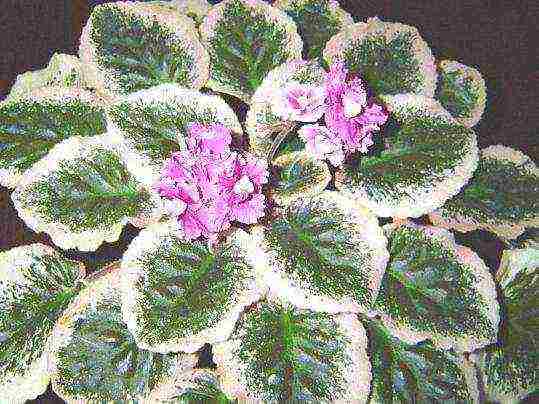 Air humidity for good rooting should be high, and the temperature within 20-24 degrees. It is better to build a small greenhouse on top, or put the container in a bag. Children should appear in a month or a month and a half. After they get stronger, you need to separate them. We do this very carefully, minimally damaging the root system. We put the kids in a separate pot. Each petiole that a violet gave (varieties, the photo is in this article) can form several shoots. The planting container should not be too large, no more than 6 centimeters in diameter. If the donor leaf remains strong, then it can be left for re-rooting.
Air humidity for good rooting should be high, and the temperature within 20-24 degrees. It is better to build a small greenhouse on top, or put the container in a bag. Children should appear in a month or a month and a half. After they get stronger, you need to separate them. We do this very carefully, minimally damaging the root system. We put the kids in a separate pot. Each petiole that a violet gave (varieties, the photo is in this article) can form several shoots. The planting container should not be too large, no more than 6 centimeters in diameter. If the donor leaf remains strong, then it can be left for re-rooting.
Landing kids
When planting, be sure to use drainage, which we put on the bottom of the pot. It can be sphagnum moss, polystyrene or small expanded clay. We choose a special soil for Saintpaulias. It should be loose, soft and nutritious. You can add vermiculite and perlite to it (one-fifth of the volume of the soil). You can also dilute the soil with sphagnum moss by cutting it into smaller pieces. For children, you can build a greenhouse for 2-3 weeks for adaptation. We put them on a lighted windowsill, but not on the south side. In winter, drafts must be excluded so that the root system does not overcool. After 2-3 weeks, you need to start hardening the plants, opening the greenhouse. You need to start with 15 minutes and bring the time to 30 minutes.
Reproduction by stepchildren
Violets, the photo and name of the variety of which are mentioned in this article, are propagated by stepchildren. In order for the rooting to be successful, you need to wait for 3-4 leaves to appear in the stepson. You will need a scalpel or awl for this procedure. With their help, the stepson is carefully separated from the mother plant. It is necessary to injure the roots of both Saintpaulias and leafy cuttings as little as possible. Now you need to carry out the rooting procedure. To do this, use a pot with a substrate or a peat-humus tablet. Then the stepson is transplanted into a pot of earth and a greenhouse is made over it. After 3-4 weeks, it is necessary to start hardening, gradually removing the greenhouse. This breeding method is ideal for chimera violets and fantasy varieties.
Choosing pots
Choosing the right container for planting violets is very important. The main thing here is the diameter. Its value for young outlets and children should be 5-6 centimeters. Older plants are planted in pots with a diameter of 10-12 centimeters. It is believed that a good pot should be three times smaller than the outlet itself. The height of the pots should not be large. Violets look very nice in low containers. Both ceramic and plastic pots can be used. The second type is more affordable.
Violet care
These many-sided flowers, pink violets - varieties with delicate flowers, white - pure and innocent, red - passionate, blue - bewitching, in need of anxious care. In adult plants, it is imperative to remove old leaves that lose color and spoil the look. After removing the bottom row of leaves, add soil to the pot or cover it with sphagnum moss.With proper care, plants will delight with their magnificent flowering, and their cultivation will only bring pleasure. Provide the Saintpaulias with good lighting, a comfortable temperature, adequate humidity and watering, and, most importantly, your love, and they will reciprocate. There are so many varieties and varieties that you can start collecting them by adding new, exquisite types of violets.
The "official" name for the home violet is saintpaulia. It is prized for its velvety leaves and an incredible amount of all kinds of petal colors. This diversity provides an impressive number of varieties of violets, which breeders have bred many.
The home violet belongs to the genus Saintpaulia, to the family Gesneriaceae. It is a perennial herb with a weak rhizome. The stems of the violet are fleshy. Depending on the type, they are either shortened - and then the leaves form a rosette. Or the stems are elongated - in this case, the flower will have several outlets. The rosette can be small - 6 cm, or up to 60 cm in diameter.
A distinctive feature of violet leaves is a velvety surface. The color of the leaf is often green, but it can be with an ash or golden tint.
Saintpaulia petals are located in the same row. If there are two such rows, then this is a semi-double type of violet, and if there are more of them, it is terry. The edges of the petal can be strongly corrugated or curved in light waves. Saintpaulia has a wide range of shades - its buds are white, pink, purple, blue. Coloring can be monochromatic or variegated. The flower diameter ranges from 2.5 cm to 9 cm.
Saintpaulia, which can be grown on a windowsill, has over 30 thousand varieties. These varieties fit into 5 main types:
- star: the petals are the same size and evenly spaced in the center;
- bowl: the flower is in the shape of a bowl, the petals are not fused at the base;
- bell: the flower looks like a bell, the petals are fused at the base;
- pansies: the petals are arranged in two rows: 2 at the top and 3 at the bottom, the upper petals are smaller than the lower ones;
- wasp: 5 petals are separated: 2 upper ones are rolled into a tube, 3 lower ones hang freely.
It is also customary to distinguish variegated violets - with bright color of leaves and double flowers, collectible - with large buds and wavy petals, industrial - easy to breed Saintpaulias.
Among the tens of thousands of varieties of homemade violets, the most popular can be distinguished.
- The beauty queen.
Differs in a large double flower with bright crimson petals, iridescent purple. The foliage of the Goddess of Beauty is dark green, flat in shape. Bred by the breeder E. Korshunova.
- Black Pearl.
This is another variety bred by E. Korshunova. A distinctive feature is velvety, dark purple flowers. Saintpaulia of this variety creates an inflorescence in the form of a cap, in which there can be up to 8 corollas. One flower reaches 7 cm at its peak. The rosette at the Black Pearl is simple, of dark green foliage.
- Pauline Viardot.
Description of the variety: the wine color of this violet with a white border makes it perhaps the most noble representative of the entire family. The vertical arrangement of flowers adds solemnity. The rosette of this Saintpaulia is compact, large-sized flower. Created by Pauline Viardot E. Lebetskaya.
- Lovely Creole.
And again a variety from the breeder E. Lebetskaya. The beauty of Creole lies in its simplicity. The rosette of this violet is small and compact. At the same time, the buds are also small, the diameter of one does not exceed 5 cm. The advantage of the variety is that it has a lot of flowers, while all of them are of a beautiful dark blue color, bordered by a white edging.
These are not all the best varieties of Saintpaulia. The variety of these easy-to-care indoor plants is amazing. It is no coincidence that many flower growers collect in their home a whole collection of bright multifaceted violets.


